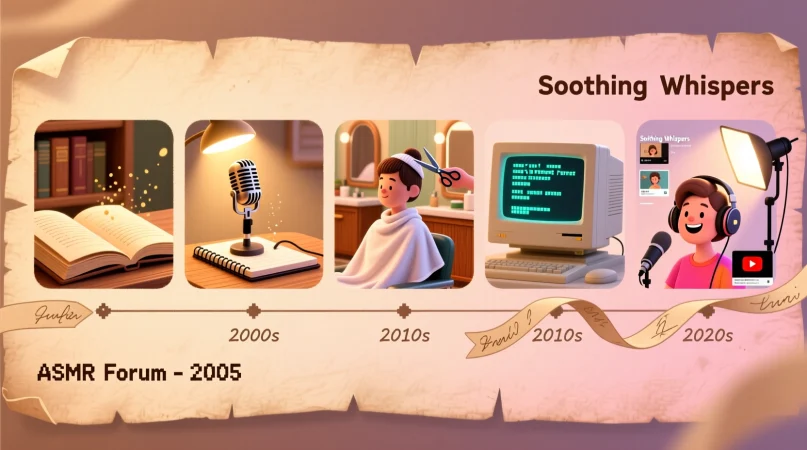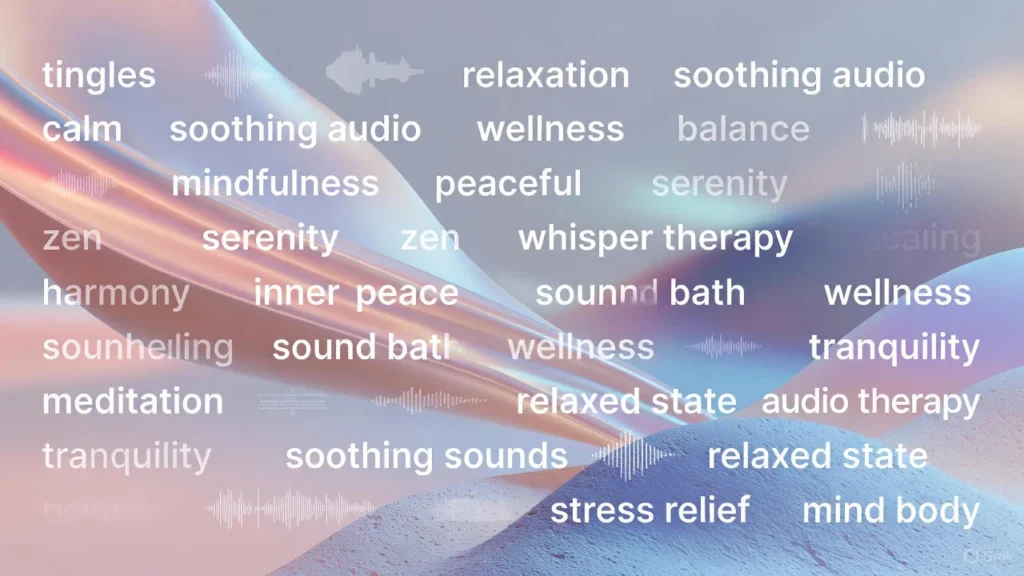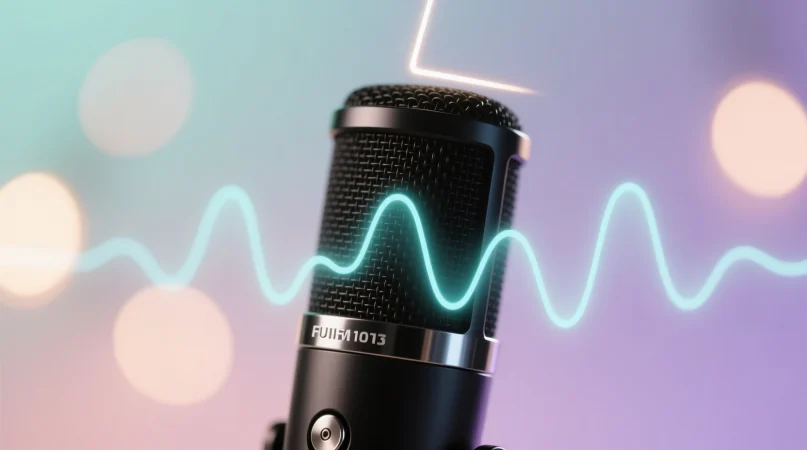ASMR means “Autonomous Sensory Meridian Response,” a calming, tingling sensation triggered by soft sounds, whispers, and gentle visuals.
If you’ve ever felt a warm, relaxing tingle down your spine while hearing soft whispers, tapping, brushing, or soothing sounds, you’ve already experienced what ASMR means. Today, ASMR videos rule YouTube, TikTok, Instagram Reels, and even podcasts. Millions search terms like ASMR meaning, what does ASMR mean in TikTok, ASMR sounds, ASMR triggers, and ASMR roleplay because this phenomenon has become a key part of wellness, sleep routines, and stress relief.
But beyond the trend, ASMR is a real sensory experience that influences the brain, mood, and emotions. This article breaks down everything: definition, origins, history, examples, types, misunderstandings, slang usage, pop-culture impact, and FAQs—all in clear, simple language. If you’re a creator, viewer, or curious beginner, you’ll find this guide helpful.
Definitions & Meaning

ASMR stands for Autonomous Sensory Meridian Response. It describes a pleasant, tingling sensation that usually begins on the scalp and moves down the neck or spine. People often describe it as:
- “brain tingles”
- “static-like relaxation”
- “sparkly calmness”
- “soft shivers”
ASMR is triggered by gentle, sensory inputs. These are known as ASMR triggers, and the most common include:
- Soft whispering
- Light tapping
- Hair brushing sounds
- Page turning
- Crinkling paper
- Keyboard typing
- Personal attention (e.g., roleplay)
- Nature sounds (rain, wind, water)
The purpose of ASMR is to create relaxation, stress reduction, and better sleep. Many people watch ASMR videos at night because the slow, repetitive sounds activate a calming response similar to meditation or deep breathing.
Why People Search “ASMR Mean”
Social media trends often shorten phrases. Instead of typing “What does ASMR mean?” people search variations like:
- ASMR mean in text
- ASMR meaning TikTok
- ASMR means what
In all cases, the meaning stays the same: ASMR is a soothing sensory reaction triggered by gentle sounds and visuals.
ASMR as a Modern Stress-Relief Tool
Today, ASMR is connected to mental wellness, mindfulness, and relaxation practices. It is also widely used for:
- Insomnia relief
- Anxiety reduction
- Focus while studying
- Background calm during work
The experience differs from person to person—some feel tingles intensely, while others simply find the sounds soothing even without tingling.
Origins & History

Although ASMR blew up in the 2010s, the sensation itself is much older. People have experienced tingling relaxation for centuries, but there wasn’t a name for it. Some early references compare it to:
- The calm feeling from getting a haircut
- A teacher speaking softly
- A friend drawing patterns on your back
- The sound of turning pages in a library
The Term “ASMR” is Born
The term Autonomous Sensory Meridian Response was coined in 2010 by Jennifer Allen, who wanted a scientific-sounding name to describe this sensation without making it appear “weird” or sexual. She combined:
- Autonomous = happening on its own
- Sensory = related to the senses
- Meridian = a peak or climax of sensation
- Response = a reaction
Shortly after, ASMR communities exploded on Reddit, YouTube, and forums.
ASMR Goes Mainstream
By 2015–2020, ASMR had become a global internet sensation. Major creators like Gibi, GentleWhispering, ASMR Darling, JojoASMR, Latte, and dozens more built huge audiences.
Brands also joined the trend. Major companies used ASMR in ads, including:
- IKEA
- KFC
- Pepsi
- Dove
Today, ASMR is part of wellness culture. Millions use it daily for sleep, anxiety relief, and focus.
Usage in Different Contexts

1. Social Media (TikTok, YouTube, Instagram)
ASMR is huge on TikTok, where creators make bite-sized videos featuring:
- ear-cleaning roleplays
- soap cutting
- slime squishing
- tapping on microphones
- whisper challenges
Search terms include ASMR TikTok meaning, ASMR trend, and ASMR lives.
2. Professional Wellness
Therapists, sleep coaches, and meditation experts use ASMR techniques for:
- breathing exercises
- guided relaxation
- sensory grounding
- slow, repetitive calming sounds
3. Pop Culture
ASMR appears in:
- Movies
- Late-night shows
- Music videos
- Podcasts
- Advertisements
Celebrities like Billie Eilish, Cardi B, BTS, and Zendaya have participated in ASMR interviews.
4. Gaming & Streaming
Gamers use ASMR-style microphones to create immersive:
- soft keyboard clicks
- controller sounds
- whisper gameplay
5. Everyday Conversation
People casually say:
- “This sound is giving ASMR vibes.”
- “Your voice is ASMR-level calming.”
- “That video is so ASMR.”
Here, ASMR simply means soothing or tingly.
Common Misunderstandings & Clarifications

1. “Is ASMR sexual?”
No. ASMR is not inherently sexual. It’s primarily a relaxation response. Some roleplays may feel personal, but the intention is calmness, not intimacy.
2. “Everyone feels ASMR tingles.”
Not true. Many enjoy ASMR without tingles. Some feel only relaxation.
3. “ASMR is only whispering.”
ASMR includes hundreds of triggers:
- tapping
- scratching
- soundscapes
- visual hand movements
- positive affirmations
4. “ASMR is weird or cringe.”
It might seem unusual at first, but it’s backed by psychology and neuroscience. Millions use it daily to sleep better.
5. “ASMR cures anxiety or insomnia.”
It doesn’t cure, but it helps manage stress and improves relaxation.
Alternatives & Synonyms

While ASMR has no perfect synonym, several related terms help describe the feeling:
- Tingles
- Brain tingles
- Tingles sensation
- Relaxation sounds
- Soothing audio
- Whisper therapy
- Calming triggers
- Sensory relaxation
In casual speech, people use phrases like:
- “That’s so relaxing.”
- “This feels meditative.”
- “This is satisfying.”
Related content categories include:
- white noise
- binaural sounds
- meditation audio
- sleep sounds
- sound therapy
These don’t cause tingles but offer similar calming effects.
Frequently Asked Questions (FAQ)
1. What does ASMR mean?
ASMR means Autonomous Sensory Meridian Response, a relaxing tingling sensation triggered by soft sounds.
2. Why is ASMR so popular?
Because it helps people relax, sleep better, and reduce stress.
3. Does everyone feel ASMR?
No. Some feel tingles, others just enjoy the calming sounds without tingles.
4. Is ASMR safe?
Yes. It’s harmless and often recommended for stress relief.
5. What are the best ASMR triggers?
Whispers, tapping, brushing, crinkles, page turning, hair play, and personal attention.
6. Is ASMR weird?
Not at all—millions use it as a relaxation tool.
7. How do I start watching ASMR?
Search for categories you like: whisper, tapping, rain sound, roleplay, or keyboard ASMR.
Conclusion
ASMR has grown from a small internet trend to a global relaxation tool used daily by millions.
Understanding what ASMR means helps explain why so many people find comfort in soft sounds, gentle visuals, and slow, soothing triggers.
If used for sleep, anxiety relief, meditation, or simple enjoyment, ASMR is now a meaningful part of online culture and wellness routines.
As you explore different triggers and creators, you’ll discover which sounds calm your mind and help you unwind. If you feel tingles or just enjoy the peaceful ambience, ASMR offers a simple, accessible way to relax in a busy world. It’s proof that sometimes, the quietest things bring the most comfort.

